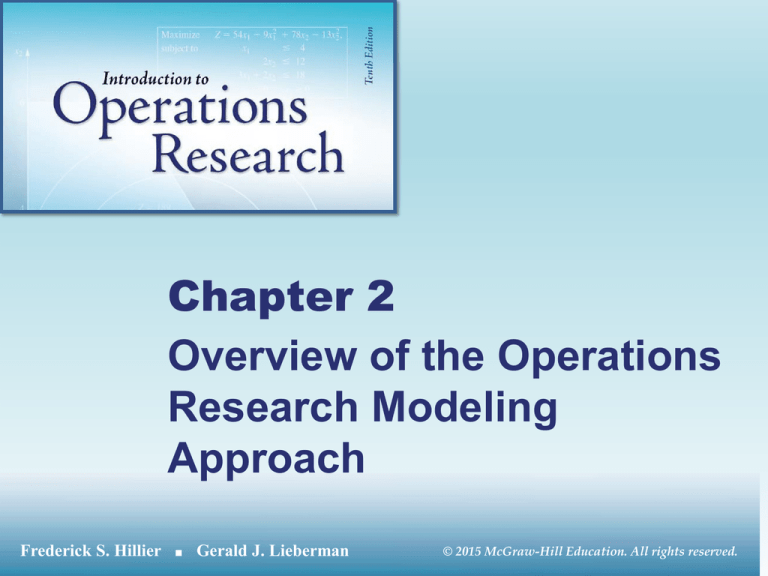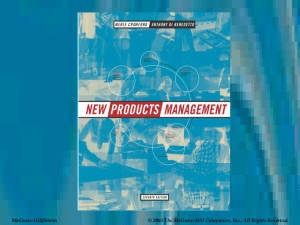
Chapter 2
Overview of the Operations
Research Modeling
Approach
Frederick
S. HillierEducation.
∎ Gerald J. Lieberman
© 2015 McGraw-Hill
All rights reserved.
© 2015 McGraw-Hill Education. All rights reserved.
2.1 Defining the Problem and Gathering
Data
• Elements of problem definition
– Identify the appropriate objectives
– Identify constraints
– Identify interrelationships with other areas of
the organization
– Identify alternative courses of action
– Define the time constraints
© 2015 McGraw-Hill Education. All rights reserved.
2
Defining the Problem and Gathering Data
• OR team typically works in an advisory
capacity
– Management makes the final decisions
• Identify the decision maker
– Probe his/her thinking regarding objectives
• Objectives need to be specific
– Also aligned with organizational objectives
© 2015 McGraw-Hill Education. All rights reserved.
3
Defining the Problem and Gathering Data
• Example of an objective in a for-profit
organization
– Maximum profit in the long run
• More typical objective
– Satisfactory profit combined with other
defined objective
© 2015 McGraw-Hill Education. All rights reserved.
4
Defining the Problem and Gathering Data
• Parties affected by a business firm
operating in a single country
– Stockholders (owners)
– Employees
– Customers
– Suppliers
– Government (nation)
• International firms obligated to follow
socially responsible practices
© 2015 McGraw-Hill Education. All rights reserved.
5
Defining the Problem and Gathering Data
• Gathering relevant data necessary for:
– Complete problem understanding
– Input into mathematical models
• Problem: too little data available
– Solution: build management information
system to collect data
• Problem: too much data available
– Solution: data mining methods
© 2015 McGraw-Hill Education. All rights reserved.
6
2.2 Formulating a Mathematical Model
• Models
– Idealized representations
– Examples: model airplanes, portraits, globes
• Mathematical models
– Expressed in terms of mathematical symbols
– Example: Newton’s Law: F = ma
• Mathematical model of a business
problem
– Expressed as system of equations
© 2015 McGraw-Hill Education. All rights reserved.
7
Formulating a Mathematical Model
• Decision variables
– Represent the decisions to be made
– Examples: x1, x2, ….xn
• Objective function
– Performance measure expressed as a
function of the decision variables
– Example: profit, P
𝑃 = 3𝑥1 + 2𝑥2 + ⋯ 5𝑥𝑛
© 2015 McGraw-Hill Education. All rights reserved.
8
Formulating a Mathematical Model
• Constraints
– Mathematical expressions for the restrictions
– Often expressed as inequalities
– Example:
𝑥1 + 3𝑥1𝑥2 + 2𝑥2 ≤ 10
• Constants in the equations called
parameters of the model
– Example: the number 10 in the above
equation
© 2015 McGraw-Hill Education. All rights reserved.
9
Formulating a Mathematical Model
• Determining parameter values
– Often difficult
– Done by gathering data
• Typical expression of the problem
– Choose values of decision variables so as to
maximize the objective function
• Subject to the specified constraints
• Real problems often do not have a single
“right” model
© 2015 McGraw-Hill Education. All rights reserved.
10
Formulating a Mathematical Model
• What are the advantages of a
mathematical model over a verbal
description of the problem?
– More concise
– Reveals important cause and effect
relationships
– Clearly indicates what data is relevant
– Forms a bridge to use computers for analysis
© 2015 McGraw-Hill Education. All rights reserved.
11
Formulating a Mathematical Model
• What are the disadvantages of
mathematical models?
– Often must simplify assumptions to make
problem solvable
• Judging a model’s validity
– Desire high correlation between model’s
prediction and real-world outcome
– Testing (validation phase)
– Multiple objectives may be combined into an
overall measure of performance
© 2015 McGraw-Hill Education. All rights reserved.
12
2.3 Deriving Solutions from the Model
• Sometimes a relatively simple step
• Algorithms applied in a computer using a
commercially-available software package
• Search for the optimal solution
– Common theme in OR problems
– Recognize that the solution is optimal only
with respect to model being used
– More common goal: seek a satisfactory
solution, rather than the optimal
© 2015 McGraw-Hill Education. All rights reserved.
13
Deriving Solutions from the Model
• Postoptimality analysis
– Analysis done after finding an optimal solution
– Very important part of most OR studies
– Also called “what-if” analysis
• What would happen if different assumptions were
made?
• Sensitivity analysis
– Determines which variables affect the solution
the most
© 2015 McGraw-Hill Education. All rights reserved.
14
2.4 Testing the Model
• Model validation
– Process of testing model output and
improving the model until satisfied with output
• Computer program analogy
– Find and correct major bugs
– Determine flaws in the model
• Example of flaws:
– Factors that were not incorporated
– Parameters that were estimated incorrectly
© 2015 McGraw-Hill Education. All rights reserved.
15
Testing the Model
• Process varies with the model
• Check for dimensional consistency of units
– In all mathematical expressions
• Vary values of parameters and/or decision
variables
– See if output behaves in a plausible way
© 2015 McGraw-Hill Education. All rights reserved.
16
Testing the Model
• Retrospective test
– Uses historical data to reconstruct the past
– Determines how well the model and solution
would have performed
• If it had been used
• Disadvantages of the retrospective test
– Uses same data as used to formulate the
model
– The past may not be indicative of the future
© 2015 McGraw-Hill Education. All rights reserved.
17
2.5 Preparing to Apply the Model
• Install a well-documented system for
applying the model
– Includes the model, solution procedure, and
implementation procedures
– Usually computer-based
• Databases and management information
systems
– Provide up-to-date model input
© 2015 McGraw-Hill Education. All rights reserved.
18
Preparing to Apply the Model
• Decision-support system
– Interactive, computer-based system
– Helps managers use data and models to
support their decision-making
© 2015 McGraw-Hill Education. All rights reserved.
19
2.6 Implementation
• Benefits of the study are reaped during
implementation phase
• Important for OR team to participate in
launch
– To make sure model is correctly translated
• Success of implementation depends on
support from:
– Top management
– Operations management
© 2015 McGraw-Hill Education. All rights reserved.
20
Implementation
• Steps in the implementation phase
– OR gives management explanation of new
system
• How does it relate to operating realities?
– Develop procedures to put system into
operation
• Responsibility of OR team and management
– Initiate new course of action
– OR team evaluates initial experience
– Gather feedback
© 2015 McGraw-Hill Education. All rights reserved.
21
Implementation
• Steps in the implementation phase
(cont’d.)
– Document methodology
• Work should be reproducible
– Periodically revisit assumptions
© 2015 McGraw-Hill Education. All rights reserved.
22
2.7 Conclusions
• Subsequent chapters focus on
constructing and solving mathematical
models
• Phases described in the chapter are
equally important
• There are always exceptions to the “rules”
– OR requires innovation and ingenuity
© 2015 McGraw-Hill Education. All rights reserved.
23






